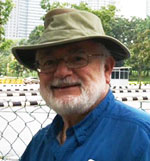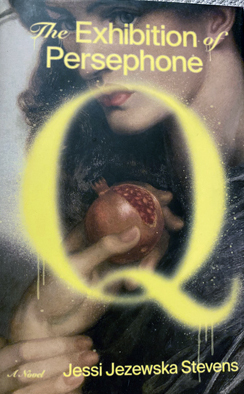The Exhibition of Persephone, A Novel by Jessi Jezewska Stevens (New York: Farrar, Straus and Giroux, 2020) 213 pages, $26

 TETON VILLAGE, Wyoming — Michelle Obama’s description of mild depression was communicable. I awoke the following morning feeling a bit slumpy. Some change, realignment, was called for. I reduced cellphone use, exercised, redirected energy and efforts, sought productive distraction, perhaps a novel. We stood socially distanced to purchase delectables at Persephone’s Bakery in Wilson, Wyoming.
TETON VILLAGE, Wyoming — Michelle Obama’s description of mild depression was communicable. I awoke the following morning feeling a bit slumpy. Some change, realignment, was called for. I reduced cellphone use, exercised, redirected energy and efforts, sought productive distraction, perhaps a novel. We stood socially distanced to purchase delectables at Persephone’s Bakery in Wilson, Wyoming.
Three stores away stood Wilson Book Gallery. Wanting to support valiant independent bookstores I browsed for something different. The debut novel by Jessi Jezewska Stevens, The Exhibition of Persephone Q, attracted my attention. A pomegranate inside a Q emblazoned the cover. The publisher was the formidable Farrar, Straus and Giroux. Paul Beatty’s back cover blurb proclaimed, “Finally—a book that exposes how dull Occam’s razor has become after all these years.” We had discussed Occam’s razor and Kuhn’s Paradigm at dinner the previous evening. The sirens said buy it.
The author, born in 1990, earned her Mathematics degree from Middlebury College and completed an MFA in fiction at Columbia University in 2018. The novel is set in crisis plagued New York around 9/11 2001.
The author drops almost poetic hints; “Lower Manhattan opened its gates to the general public again…a light northward breeze perfumed the air with drywall dust and soot…we looked south and saw the great gap tooth against the gullet of the sky.” We were at war, from where would the next terror come?
The trauma of 9/11 recalled some childhood and family losses. Percy, a recent bride, pregnant, and retching, became a somnambulist walking the streets at strange hours while her Bulgarian husband slept. She did not share the news of pregnancy with him, he saw the positive test in the trash can. Despite her love for Misha without malice considered murdering him by pinching his nostrils. She dwells on the mysterious disappearance of older neighbor who she liked. She consulted a psychic who used tarot cards.
Ten years earlier she had been an art curator engaged to “The Fiancé,” an aspiring photographer with whom she had no further contact during the intervening decade. One morning the mailman delivered a package addressed to her apartment but with no name on it. Suspicion, paranoia, an innocent or lethal package? It was an art gallery catalogue of nude photographs for an upcoming show, “The Exhibition of Persephone Q.” Persephone was the Greek goddess of spring and the wife of Hades. The fiancé was now a successful photographer. Percy was convinced the sleeping languid unidentified female nude on a bed was her. Nothing in the catalogue gives her credit. How does she prove her role as muse?
Some turn of the century terms evoke nostalgia; Microsoft Encarta, anthrax, Napster, ask Jeeves, Discman, on screen hourglass, pioneering online purchasing during the dot-com era, JSTOR’s early days, the RadioShack salesman predicting the obsolescence of answering machines. The human quotidian included hangnails and popup toasters that don’t popup.
There is nothing palpably Jewish in the novel except mentioning Proust on page 13, “the bombed-out boulevards of Warsaw” on page 53, and four pages from the end of the 212-page novel that the hospital “Shabbat elevator” was out of order. Pretty slim Jewish pickings, but a little Googling found three Jessi Jezewska Stevens stories in 2019-2020 verifying the mantra, “There’s a Jewish story everywhere.”
4 Columns, (website) March 15, 2019: Stevens reviewed Croatian writer Daša Drndić’s last novel EEG published in 2016 which confronts European authoritarianism. She died of cancer in June 2018 at the age of 71. Stevens mentions Stefan Zweig, the Nazis and the NKVD.
“The lengthiest of these digressions is devoted to the Nazi and Soviet occupations of Latvia, an unflinching chronicle brought about by Ban’s research into the life of his uncle’s former fiancée Frida Landsberg, a Jewish-Latvian violinist who disappeared in Riga. The precision with which Drndić traces the history of this fictional family—Frida’s father’s shoe factory is nationalized under the Soviets in 1940, while Frida, still a student at the Riga Conservatoire, is transferred to the Jewish ghetto when the Nazis invade in 1941—speaks to EEG’s encyclopedic care. Most of these “characters” are actual historical figures. Drndić roll calls the victims of fascism at length, and is especially interested in exposing esoteric horrors that have escaped public scrutiny: the Croatian Ustasha, the Riga ghetto, the Sonderkommando Arājs—a cadre of Latvian volunteers charged with the “spontaneous” elimination of the Jewish population—and the CIA’s clandestine embrace of former Arājs members during the Cold War.”
In “We Tell Ourselves Stories in Order to Die” which appeared in January 13, 2020 in the Paris Review reveals, “I came about my uneasiness with Christian theology of the afterlife as honestly as one can. My parents, themselves raised Catholic, did not baptize me; my father objected to the involuntary nature of the rite; my mother wanted “nothing to do” with an institution that denied the use of birth control and same-sex marriage rights. My mother’s extended family is Jewish (my aunt converted when she married), but they live across the country, and so I was raised without any formal religious education at all, and certainly without the prospect of damnation. At best, faith floated through my life on holidays, and even then in only performatively secular ways. One Christmukkah, after my mother accidentally swapped the salt and the sugar in my cousin’s kitchen, both in jars labeled in Hebrew, we sank our forks into saline apple streusel with a groan.”
In “Ode to Roof Tops” Paris Review, March 5, 2020, she tackles the legacy of Philip Roth: “In Philip Roth’s “The Conversion of the Jews,” an overly inquisitive Hebrew school student flees to the roof after calling his rabbi a bastard. The better part of the story takes place up here, as Ozzie Freeman evades the anxious attempts of community elders, the fire department, his mother, to coax him down to earth and spare the congregation considerable embarrassment. “So far it wasn’t-so-bad-for-the-Jews,” the narrator says, “But the boy had to come down immediately, before anybody saw.” Onlookers encourage him to leap into the fireman’s net, but Ozzie’s power grows the longer he holds out: “Being on the roof, it turned out, was a serious thing… [he] wished he could rip open the sky, plunge his hands through, and pull out the sun; and on the sun, like a coin, would be stamped JUMP or DON’T JUMP.” He makes the entire temple pledge allegiance to Jesus Christ before he acquiesces; escaping to the roof, in a way, makes him more powerful than the rabbi.”
Novels about the 1340’s, London in 1665, and 1918 pandemic fed by incomplete information and disinformation are surreal and fabulist. We are living in the minds of novels yet unwritten.
The increased speed of transmission and our reliance on science reveal our complete grasp. This exegetical search for Jewish content would be impossible without the internet and Covid19 enforced leisure.
*
Oliver B. Pollak, Ph.D., J.D., a professor emeritus of history at the University of Nebraska Omaha, and a lawyer, is a correspondent now based in Richmond, California. He may be contacted via oliver.pollak@sdjewishworld.com